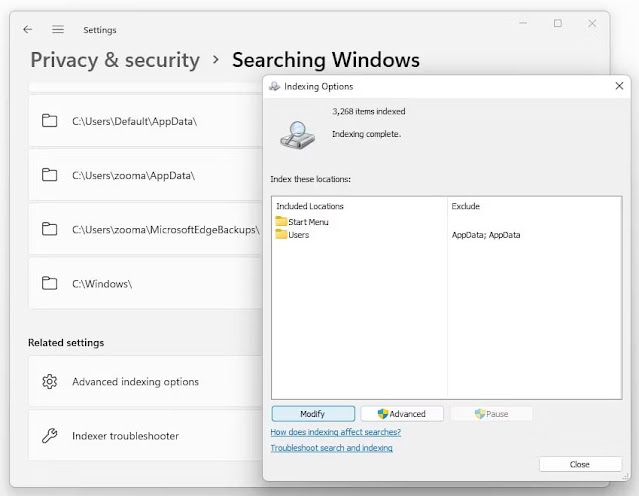In today's fast-paced world, the convenience of quickly finding and accessing files and folders is a blessing indeed. With Windows 11, you get an impressive search feature that can quickly locate what you need, whether it's local files, OneDrive documents, or even Bing results.
To exploit the full potential of this powerful search function and ensure optimal performance on Windows 11, try the search tuning techniques mentioned below. These simple yet effective tricks will enhance your search experience and increase your productivity better than ever.
1. Show cloud search results and historyWindows Search can fetch results from other Microsoft services associated with your account, such as Outlook, OneDrive, and Bing, to better serve your search queries. These integrations allow for faster and more relevant searches for you.
In addition, Windows 11 can store search results on your PC to enhance the search experience. It's understandable for you to worry about privacy issues arising, but Microsoft ensures that the data related to your search history is only stored locally on the device.
If you've recently searched for Microsoft Word, it will favor showing Microsoft Word at the top of your search results instead of Microsoft Excel.
To enable cloud content and history search in Windows 11:
1. Launch the Settings app and navigate to Privacy & security from the sidebar.
2. Under the Windows permissions group, select the tab labeled Search permissions.
3. Enable both toggles in the Cloud content search group to allow Windows Search to personalize your search results.
4. Make sure you also turn on the Search history on this device toggle.
2. Use Enhance Indexing
By default, Windows Search works on the Classic service index filtering only certain specific folders such as Documents, Music and Pictures (you can also add additional folders). While this can work in most cases, you'll need a more comprehensive search if your files are scattered across different drives and folders.
When you enable Enhanced indexing, Windows Search will build the search index from your entire file directory instead of specific directories. While this will give you comprehensive search results, it comes at the expense of battery life and CPU resource consumption.
This is how you can use the Enhanced index on Windows 11
1. From the Settings app, navigate to Privacy & security > Searching Windows.
2. Select the Find my files tab, and then click Enhanced.
3. Update Windows 11
If your Windows PC is acting up or running slowly, one of the first steps to take is to make sure that your Windows operating system is up to date. If you notice that the search feature is unusually slow, updating Windows can help resolve known issues automatically.
Updating Windows often improves performance, and if Windows Search fails on your system, you should see a significant difference after updating.
To update your Windows 11 PC:
1. From the Start menu, search for the Settings app, and then launch the Best match.
2. Select Windows Update from the side menu.
3. On the top right, choose the Check for updates button. If Windows has already fetched the latest updates, you should select the Download & Install button instead.
4. Once the updates get installed, you’ll have to restart your PC so that the changes can take effect.
Updating Windows usually leads to improved performance, and if Windows Search was buggy on your system, you should see a significant difference after the update.
4. Run Windows Indexing & Search Troubleshooter
Microsoft has introduced several essential troubleshooters with both Windows 10 and 11. These convenient utility wizards are valuable for diagnosing and automatically resolving system problems, providing Quick and efficient fixes.
Among the tools available, Windows Indexing & Search Troubleshooter stands out for its ability to detect potential search and indexing service problems. It provides a quick and simple solution to solve problems with Windows Search just by running the troubleshooter.
To launch Windows Indexing & Search Troubleshooter and fix common problems with search indexes:
1. Launch the Settings app through the Start menu.
2. Select System from the sidebar and then select the Troubleshoot tab.
3. In the Options group, select Other troubleshooters and find the Search and Indexing tab from the list.
4. Click Run to launch Windows Indexing & Search Troubleshooter.
5. If the troubleshooter finds any search or indexing related issues, the troubleshooter will ask you for confirmation to fix those issues.
6. After restarting your computer, you will notice a significant improvement in Windows search speed, making it easier for the search function to quickly and efficiently resolve your queries.
5. Rebuild Windows 11 Index
The above steps should improve search performance significantly, but if still not satisfied, you can try rebuilding the entire search index. Since the search index is similar to the table of contents (but more massive with millions of entries), rebuilding the index can help optimize the time it takes to find specific files.
Note: After deciding to rebuild the search index, you should allow the Indexer to run for up to 24 hours. This ensures that the Windows search function properly and efficiently indexes all the necessary files on your system.
If you want to rebuild the Windows 11 search index:
1. Open the Settings app from the Start menu.
2. Navigate to Privacy & security > Searching Windows.
3. At the bottom you will see Advanced indexing options listed under Related settings.
4. Click Advance when prompted and then select OK.
5. From the Advanced options window, click Rebuild and finally select OK.
Make Windows Search Faster
Windows 11 is inherently fast, but by incorporating search best practices, you can take your search experience to a whole new level of efficiency. You will be extremely productive after learning detailed information about Windows Search.















No comments:
Post a Comment